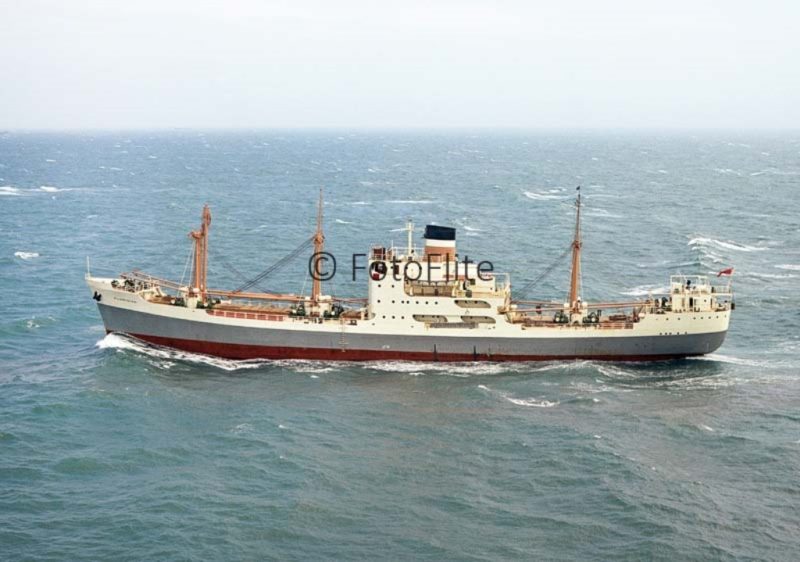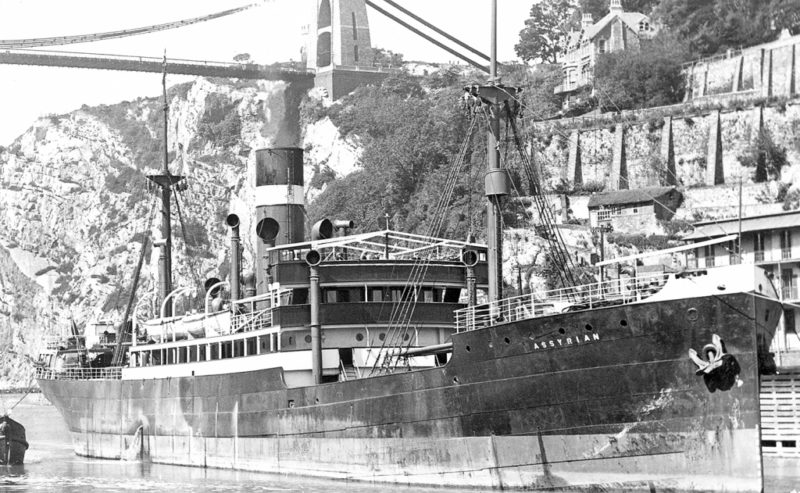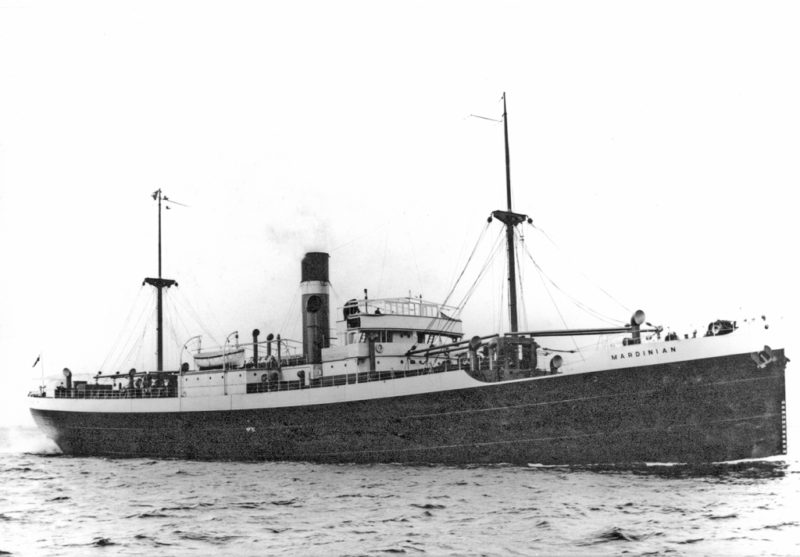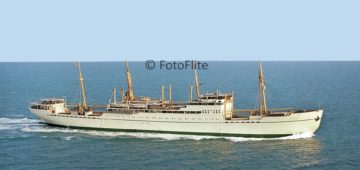
British sailing packet ships owned by the British Government left Liverpool, London and other British ports with the mail and some cargo for Gibraltar, Malta, Alexandria and Cyprus in the early 19th century. By the mid 19th century, commercial steamers and sailing ships were used on regular Mediterranean routes to at least six Portuguese ports, seven Spanish ports, ten Italian ports, seven French Mediterranean ports as well as to Gibraltar, Algiers, Tunis, Malta, Alexandria, Limassol, Larnaca, Beirut, Piraeus, Patras, Smyrna, Syra, Istanbul, Jaffa, Haifa, Odessa and other Black Sea ports.
The main and largest fleets were those of Ellerman & Papayanni Lines, MacAndrews & Company, Manchester Liners and Prince Line Mediterranean services, Cunard Line Mediterranean services, and Moss Hutchison Line, which took in the General Steam Navigation Co. Ltd. I have written separate articles on Moss Hutchison Line detailing the extensive Moss Line of Liverpool and J. & A. Hutchison of Glasgow fleets from the early 19th century, and on Prince Line. There were many other British shipping lines engaged in the trade e.g. Golden Cross Line, Mossgiel Steamship Co. Ltd., Borchard Line established in 1933 in the liner trades and has since used chartered tonnage to this day, and Gracechurch Line established in Newcastle in the mid 1950s with three Mediterranean liner ships and today part of Borchard Line using chartered tonnage. A current and much more recent British Mediterranean liner fleet is the ‘Red Dragon’ fleet of Charles M. Willie & Co. Ltd. of Cardiff with their large fleet of Mediterranean traders of up to 4,800 dwt with ‘Celtic’ prefixes to their nomenclature.

ELLERMAN & PAPAYANNI LINES
Georges Papayanni arrived in London in 1832 to establish a Greek commodity house dealing mainly in the import of dried fruit as well as the export of goods and machinery from the industrial heart of the North of England. He transferred his business to Liverpool in 1844 with the import of cotton for the Lancashire cotton mills and the increasing export of cotton clothing. Greek chartered ships were used with his brother Basilio as his Piraeus chartering agent. Viana, Jones & Chapple inaugurated sailings from Liverpool to the Mediterranean on their steamer Rattler in 1845, with Georges Papayanni booking space on her. Georges Papayanni took British citizenship in 1852 after twenty years of successful trading with Greece, the Black Sea and the Levant, with the first owned steamer being Arcadia of 1,901 grt completed in 1852 as a brig for the service terminating at Constantinople. She carried 32 First Class passengers, and a two cylinder steam engine gave a service speed of nine knots. Arcadia was lengthened in 1875 by Thompson & Company of Newcastle, and doubled the engine power with a second single expansion steam engine and new boilers fitted to give her 43 years of service by the time she was broken up in Preston in 1898.
Thessalia and Laconia were sisters of Arcadia with three masts and were clipper bowed, with the next steamer having four masts and a barque rig in 1857 and named Agia Sophia (Queen Sophia), and was lengthened in 1872 and then sold to John Reeves Ellerman in 1901, two years before she was broken up at Livorno after a career of 46 years. The fleet grew to five ships in 1859, and with Papayanni entering the Egyptian cotton trade in 1861 it grew to nine ships throughout the 1860s and 1870s with, however, no attempt made to grow the fleet beyond this size.
The Papayanni Steamship Co. Ltd. was formed in 1897 very much as a family concern with Michael Papayanni, the son of the founder, in control along with Basilio Papayanni. However, Basilio Papayanni died in that year of 1897 and his place in the family business was taken by his son Basilio, and since the company shares were now spread across three daughters and two sons, and with no capital injection by these siblings, no ship rebuilding programme was begun.


Nicholas Papayanni, the second son, negotiated the sale of the company to John Ellerman Reeves on 17th June 1901 together with eight steamers in Agia Sophia, Adalia, Anatolia, Ararat, Britannia, Laconia, Plantain and Roumelia. The price paid by Ellerman was £132,750 plus the goodwill of the trade, and on 22nd January 1902 the fleet became Ellerman owned in Liverpool but still traded as Papayanni Line until the Ellerman & Papayanni Co. Ltd. was formed in 1906, with the ships being Ellerman owned and Papayanni managed.
Whereas Ellerman & Papayanni was a West Coast loading line for the Mediterranean from Glasgow, Liverpool and South Wales ports, Westcott & Laurance was an East Coast loading line for the Mediterranean from Leith, Tyne, and London. Capt. George Westcott was a shrewd Master of a ship owned by the Greek family of Stephanos Xenos, and his ship was lying at Malta when news arrived that Stephanos Xenos had gone bankrupt. The ship was bunkered with the help of another Xenos employee named Gollcher, and it returned to London where Capt. George Westcott set up in business in 1863 with yet another Xenos employee as Westcott & Houseden. A chartering expert such as Robert Houseden and a shrewd Master such as Westcott were successful enough to purchase their first ship, the steamer Harriet Agnes of 624 grt in 1867, with Continental cargo booked by Westcott & Flint of Antwerp. The Newcastle agents of F. A. Hodgkinson & Company and J. Coull & Sons acted as loading brokers for the whole of the North and the Midlands.
The second Westcott steamer was Rhone of 1,343 grt purchased in 1879 for Westcott & Laurance, as Charles Laurance had taken over as a partner after the death of Robert Houseden, with Rhone skippered by John Richard Westcott, son of the founder. Charles Laurance died in 1889 and his place was taken by William George Westcott, the elder son of the founder. By 1901, the Westcott & Laurance fleet stood at nine ships in Avoca, Cedardene, Gulf of Suez, Joshua Nicholson, Orchis, Orestes, Perim, Plymothian and Tenedos. After the death of George Westcott, the founder, in May 1901, this fleet was then sold in December 1901 to John Ellerman Reeves giving him an East Coast loading fleet to add to Ellerman & Papayanni on the West Coast, and thus gain him a very important share of the British trade to and from the Mediterranean.
Subscribe today to read the full article!
Simply click below to subscribe and not only read the full article instantly, but gain unparalleled access to the specialist magazine for shipping enthusiasts.




Comments
Sorry, comments are closed for this item